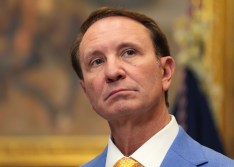Longtime Louisiana employee and first statewide CIO Dickie Howze has retired

After 45 years of working for the Louisiana state government “nearly every single day,” Richard “Dickie” Howze said he’s ready for some time off.
Howze, who served as the statewide chief information officer for nearly 11 years, stepped down at noon local time on Monday as Republican Jeff Landry was sworn in as governor. Howze said he was given short notice of Landry’s decision to install his own leader atop the Office of Technology Services, a department overseeing IT for the entire state that Howze helped create under former Gov. Bobby Jindal, a small-government Republican who, Howze said, was mainly interested in technology’s capacity to consolidate overlapping government functions and eliminate waste.
As the first CIO in Louisiana with the power to administer IT from the consolidated, 800-person office, Howze had a unique opportunity to change how the state used technology. From Jindal’s cost-cutting era to the governorship of Democrat John Bel Edwards, Howze led initiatives that first saved millions and later eliminated a backlog of technical debt exceeding $1 billion. Everything from giant IT systems like the state’s $150 million medical eligibility system to frontline staffs’ desktop computers saw radical change during Howze’s tenure.
The changes are especially pronounced when compared to his start in 1978, when he accepted a role at the Louisiana Department of Children and Family Services.
“I was attracted to public service because my mother worked in public service all of her life and so did my brother,” Howze said in a phone interview. “And so hearing the advantages of what public service offers — a very nice retirement system, sick leave and vacation time — for those reasons and the fact that my parents instilled in me ‘you need to think about what you want to do’ and they said the state’s a really solid place to work and you ought to at least consider the public sector.”
Howze said he completed a rudimentary two-year “computer operations” program in the Louisiana Community and Technical College System before applying, and that he never seriously considered a role in the private sector at any time during the past five decades.
“The computer industry in the 80s and 90s was exploding. There were multiple opportunities for me to seek other opportunities but, I don’t know, I just never felt the need to do that,” he said. “When I finished [community college] I was like, ‘OK, I’m ready to go to work,’ so I did not pursue a four-year degree thereafter. I went to work and never looked back.”
After four years at Children and Family Services, Howze tried his hand at application development, but later decided he preferred jobs like installing software and managing mainframe applications. He worked his way up to manager of the department’s technical support division, then IT director and eventually department undersecretary. In 2012 he was was asked to leave the department to head the state’s consolidated IT office, the centerpiece of a variety of restructuring that’s seldom popular among staff.
Howze said many agency leaders and staff in Louisiana didn’t like the consolidation at first either.
“[If I hadn’t been named CIO], I would have wanted to maintain and be in charge of my own destiny without consolidating all the server people into one huge group and letting them provide services back to me,” he said. “That’s what the lion’s share of the employees and the agencies themselves felt like: ‘Hey we’ve run IT for all these years. I don’t want to give it up. I don’t want to receive services from somebody that I may not know.’”
But after one year of eliminating overlapping software — including 12 help desk tools — and getting better deals on bulk software licenses, he said, the new office had managed to save the state $75 million, a result that became tough for people to argue with.
When Edwards took office in 2016, Howze said, he was summoned to explain to the new governor what the technology office had been doing in recent years. CIOs are frequently replaced when a new governor is elected, and especially when there’s a party change, but Howze said Edwards was pleased with the success of the consolidation and kept him as his CIO.
But unlike Jindal, Edwards was ready to spend on IT. In 2017, the state legislature ordered a report cataloging all of the state’s outdated hardware and software. Howze’s office delivered a report estimating the state was sitting on $1.3 billion in technical debt. But as of his retirement this week, after two terms of replacing old systems under Edwards, Howze told StateScoop, that number had shrunk to just $100 million.
“All of the 8 years, we worked against that report,” he said. “We had it all prioritized. That’s only as the result of the investment the administration chose to make, because if they didn’t give us the money, we couldn’t have done any of it.”
He said two of the largest upgrades were to Louisiana’s medical eligibility system and its Supplemental Nutrition Assistance Program, which cost about $150 million each. But, Howze said, the state’s technology was revamped from top to bottom — hardware, infrastructure, networking, many applications and even how agencies pay for their desktop computers. A longstanding budgeting challenge was solved by offering agencies an option to lease computers through the central IT office instead of buying them.
Overall, he said, the consolidated IT model has proved to work well for agencies.
“We have a huge virtual server farm in each data center with the ability to migrate workloads to the cloud,” Howze said. “And it’s all managed and maintained and the agencies never have to worry about an outlay of cash to replace in many cases old unsupported equipment that we inherited.”
Retired, Howze said he doesn’t have many plans outside of maybe doing a little work as a contractor and helping his church.
“Obviously after spending 45 years of my life reporting for duty nearly every single day, I think I’m going to take a break to kind of decompress for a while, because let me tell you, operating in a state CIO role is high pressure 24 by 7,” he said. “I’m probably going to be relatively selective about how much of my free time I commit to working.”
And like most of government’s top technology leaders, Howze credited his own success to his team.
“As CIO, you don’t do the coding, you don’t do the network upgrades,” he said. “You find the money to maintain the buildings and fortify the data centers, but they’re the ones that do the work. And for that I’ll forever be grateful to have had a dedicated team.”






